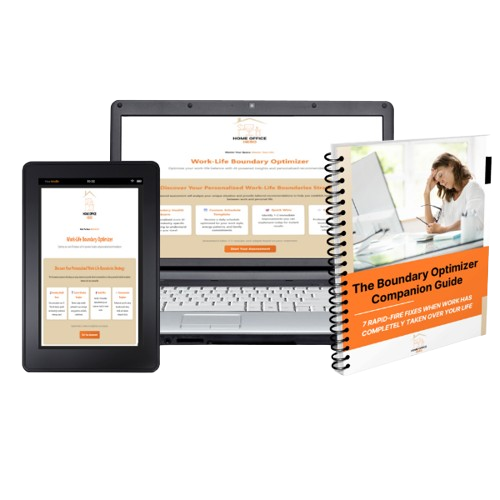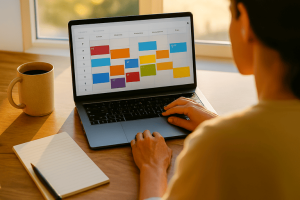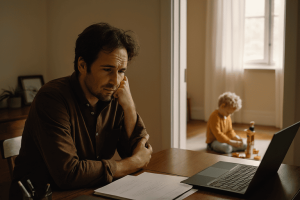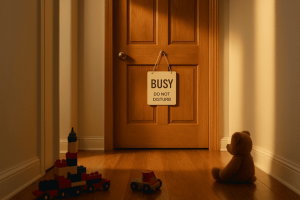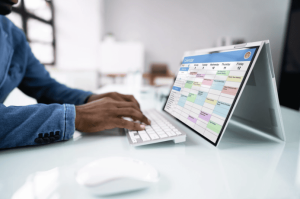The email notification pinged at 11:43 PM. Another potential client—the third one that week—declining my proposal. “Given the current economic climate, we’re putting all marketing initiatives on hold indefinitely. We’ll reach out when things stabilize.”
When things stabilize.
I closed my laptop and stared at the ceiling of my bedroom-turned-office, my mind already spinning through the calculations I’d done a hundred times that day. Mortgage payment due in nine days. Household bills stacking up. No rugby coaching income anymore—that had stopped when COVID hit. And now, week after week, my digital marketing pitches were getting the same response: “Not right now. Maybe later. We just can’t justify the spend.”
I understood. Of course I understood. Businesses were fighting for survival. Marketing services were the first thing to cut. But understanding didn’t pay my mortgage.
So I did the only thing I knew how to do: I worked harder. Sent more proposals. Stayed up later refining my services. Woke up earlier to chase leads. Worried longer about what would happen if I couldn’t make the numbers work.
I’ve been an incessant overthinker and worrier for most of my adult life, but COVID amplified it to a level I’d never experienced. Every declined proposal triggered hours of anxious mental spiraling. Every slow week meant sleepless nights running worst-case scenarios. The isolation of lockdown meant I had no outlet—no rugby training to coach, no team environment to be part of, just me alone with my racing thoughts and declining bank balance.
The deterioration happened gradually, then suddenly. Sleep dropped to 4-5 hours a night because I couldn’t turn my brain off. Meals became whatever was quickest—usually eaten while simultaneously sending emails or updating my website. Exercise, which had always been my foundation, became this exhausting thing I had to force myself through on empty. I had no energy, but I kept pushing because what else was I supposed to do? Stop working? That would make everything worse.
The worst part? I became someone I didn’t recognize. Short-tempered with Shaw over minor things. Agitated with Hayley about nothing. No patience for normal family chaos. They weren’t doing anything wrong—I was just running on fumes and frustration, and they were getting the worst of me.
One afternoon, after I’d snapped at Shaw for the third time over something trivial, Hayley pulled me aside. “You need to stop,” she said quietly. “This isn’t sustainable. You’re destroying yourself trying to save the business, but we’re losing you in the process.”
She was right. I felt desperate, isolated, helpless—and my solution had been to work more hours and sacrifice everything that actually kept me functional. This is part of our complete guide on work-life balance for remote working parents, where we explore not just productivity, but sustainable wellbeing.
That conversation became my wake-up call about something nobody talks about enough: remote work mental health isn’t a luxury you address when business stabilizes—it’s the foundation that allows you to survive the unstable periods.
If you’re reading this while exhausted, anxious, or telling yourself you’ll rest “when things calm down”—if you’re working longer hours while your health deteriorates because you don’t know what else to do—this post will show you the warning signs I missed and the seven protective practices that pulled me back from burnout before I lost everything I was working so hard to protect.
The Hidden Mental Health Crisis of Remote Work
Here’s what surprised me most about working from home: the flexibility that was supposed to reduce stress actually amplified it.
When I worked in an office during my corporate days, work ended when I left the building. My commute created a natural buffer between professional and personal life. But working from home? There was no off switch.
I’d finish a client call at 6 PM and immediately walk to the kitchen for family dinner—except mentally, I was still in the meeting. I’d close my laptop at 10 PM and lie in bed replaying the day’s mistakes. I’d wake up at 3 AM thinking about tomorrow’s deadlines and check emails from my phone.
The isolation compounded everything. During rugby, I had teammates. In offices, I had colleagues. Working from home, I had Zoom squares—people I worked with but never really connected with. When I struggled, I struggled alone.
The pandemic made it worse for everyone. Suddenly, millions of parents were thrust into remote work without preparation, without proper workspace, often while simultaneously managing their children’s remote learning. The boundaries we’d fought to establish vanished overnight.
Research shows remote workers report higher rates of anxiety, loneliness, and burnout than office workers—not because remote work is inherently harmful, but because we’re not protecting our work from home wellbeing the way we should.
Looking back, the warning signs were everywhere. I just didn’t recognize them until I was already drowning.

Warning Signs You’re Ignoring
I missed these signs for months. Maybe you’re missing them too:
Physical symptoms I dismissed:
- Constant fatigue that sleep didn’t fix
- Tension headaches every afternoon
- Jaw pain from grinding teeth at night
- Getting sick repeatedly—my immune system waving white flags
Mental and emotional red flags:
- Snapping at Shaw over minor things
- Feeling detached during family time—physically present but mentally absent
- Sunday night dread that started Saturday afternoon
- Inability to enjoy anything because I “should be working”
Behavioral changes I rationalized:
- Checking email compulsively—first thing in morning, last thing at night
- Working through lunch because “I don’t have time to stop”
- Canceling exercise because “just one more task”
- Scrolling social media for hours because my brain needed numbness
The dangerous part? I told myself this was normal. “Everyone’s stressed. I’m running a business. I’m a parent during a pandemic. Of course I’m tired.”
But remote work mental health isn’t about eliminating all stress—it’s about recognizing when stress has become chronic, when coping mechanisms have become harmful patterns, when your wellbeing has become the price you pay for productivity.
The turning point came when Shaw asked, “Dad, why are you always angry now?”
I wasn’t angry. I was depleted. And he could feel it.
7 Protective Practices for Mental Wellbeing
After that wake-up call, I rebuilt my approach to remote work mental health from the ground up. Not overnight—gradually, one sustainable practice at a time. These seven practices kept me from burning out again:
Practice 1: The Morning Mental Buffer
I used to roll out of bed and immediately check emails. Terrible idea. Now I protect the first 30 minutes of my day: no phone, no laptop, no work thoughts.
My morning ritual: Wake up, make coffee, sit outside for 10 minutes. That’s it. No productivity goals. No optimization. Just… existing before the day’s demands begin.
This buffer creates space between sleep and work mode. It lets my nervous system wake up gradually instead of spiking straight to cortisol.
Start small: Even 5 minutes makes a difference. Sit with your coffee. Look out the window. Let your brain boot up slowly.
Practice 2: Movement Before Midday
During my burnout phase, I made two mistakes with exercise. First, I kept forcing myself through workouts while running on empty—dragging myself to the gym on 4 hours of sleep and no proper meals, telling myself I “had to” maintain the routine. Exercise stopped being restorative and became another exhausting obligation on my list.
Then, when even that became too much, I stopped altogether. “Too busy. Too tired. I’ll start again when things calm down.” Classic mistake—sacrificing the thing that protects my mental health to make more time for the things that stress it.
Now, movement is non-negotiable. But I completely rebuilt my approach. Not intense workouts that drain me further—just 20-30 minutes of walking, stretching, or light exercise before noon. This dramatically improved my work from home stress levels.
The timing matters. Morning movement regulates cortisol, improves focus, and sets a healthier tone for the entire day. Evening exercise is better than nothing, but morning movement is mental health prevention.
Implementation: Block it in your calendar like a meeting. Tell your family it’s protected time. Use Shaw’s school drop-off as a walking opportunity.
Practice 3: The Hard Stop
This was my biggest breakthrough: creating a non-negotiable end to my workday.
At 6 PM, I close my laptop. Put my phone in another room. Change my shirt—yes, really. These physical rituals signal to my brain: work is done.
Some days I need to work evenings. That’s fine. But I take a 2-hour break first. Dinner with family. Bedtime with Shaw. Then, if genuinely needed, I’ll return to work at 8:30 PM with fresh energy.
The hard stop isn’t about working less—it’s about creating recovery time so you can show up mentally healthy tomorrow. Understanding work-life integration as a better approach than balance means knowing when to fully step away.
Your version: Pick your stop time. Communicate it to clients. Honor it ruthlessly for two weeks and notice the difference.
Practice 4: Weekly Connection Time
Isolation destroys mental health. I learned this the hard way.
Now I schedule genuine human connection every week—not work calls, actual connection. Coffee with a friend. Rugby training with my old team. A phone call with someone who gets it.
For remote working parents, adult conversation that isn’t about work or kids is essential. It reminds you that you exist outside these roles.
Finding your people: Join a remote worker community. Connect with other parents navigating this. Even a 30-minute weekly call with someone who understands can prevent the isolation spiral.
Practice 5: The Sunday Reset
Every Sunday evening, I spend 30 minutes preparing for the week—not just work planning, but mental health planning.
I review: What drained me last week? What recharged me? What do I need to protect this week? Where am I vulnerable to overcommitment?
Then I proactively schedule recovery: buffer time between meetings, a midweek walk with Shaw, permission to skip the “shoulds” and protect the essentials.
This practice alone reduced my anxiety by half. When I plan for wellbeing, I’m not scrambling to react when I’m already depleted.
Practice 6: The Two-Week Check-In
Every two weeks, I honestly assess my mental health using three questions:
- Am I sleeping reasonably well?
- Am I present with my family?
- Am I enjoying anything?
If the answer to two or more is “no,” something needs to change immediately—not someday, now. I reduce commitments, ask for help, or adjust my schedule before small problems become crises.
This catches problems early, before they become burnout.
Practice 7: Professional Support
The most important practice: having a therapist.
This isn’t about crisis management. It’s about having a trained professional who helps you process stress, recognize patterns, and build better coping strategies before you’re in crisis.
I resisted therapy for years—classic “I can handle it myself” thinking. Getting professional support was the best decision I made for my remote work mental health.
When to seek help: If you’re experiencing persistent anxiety, depression, sleep problems, or feeling overwhelmed for more than two weeks, talk to a professional. There’s no shame in getting support—there’s only harm in waiting until you’re in crisis.ot hiding your work life from your family life as if they’re shameful secrets.

Implementation: Your First Week
Don’t implement all seven practices simultaneously—that’s overwhelming and likely to fail.
This week, choose ONE practice:
If you’re exhausted: Start with the morning buffer (Practice 1)
If you’re anxious: Try the hard stop (Practice 3)
If you’re lonely: Schedule connection time (Practice 4)
What to expect: The first few days will feel awkward. You’ll be tempted to skip your new practice when work gets busy. You’ll question whether it’s “worth it.”
Push through the first week. The benefits compound—small daily investments in mental wellness remote work create massive returns over time.
Common mistakes to avoid:
- Skipping practices when you’re busy (that’s when you need them most)
- Waiting until you “have time” (you’ll never have time; you make time)
- Treating mental health as optional (it’s the foundation everything else requires)
When to Seek Professional Help
These practices help maintain mental health, but they’re not treatment for mental health conditions. Seek professional support if you experience:
- Persistent anxiety or panic attacks
- Depression lasting more than two weeks
- Thoughts of self-harm
- Inability to function in daily activities
- Substance use to cope with stress
- Relationship problems due to emotional wellbeing
Resources:
- BACP (British Association for Counselling and Psychotherapy): Find qualified therapists in your area
- Mind: Mental health charity offering support and information
- Samaritans: Call 116 123 (free, 24/7) for emotional support
- NHS Mental Health Services: Contact your GP for referrals
Professional support isn’t admitting defeat—it’s taking your wellbeing seriously.
Conclusion
Remote work mental health isn’t something you figure out once and forget about. It’s an ongoing practice—recognizing warning signs early, protecting your wellbeing proactively, and adjusting when life demands it.
The irony? Taking care of my mental health made me more productive, not less. I get more done in fewer hours because I’m actually present when I work. My relationships improved because I stopped bringing work stress to family time. My business grew because I stopped making decisions from a place of depletion.
Quick Recap:
- Warning signs appear long before crisis—learn to recognize them early
- Seven protective practices create sustainable mental health (start with one)
- Professional support prevents problems from becoming crises
- Mental health isn’t optional—it’s the foundation for everything else
Your next step: Choose one practice from this post and implement it tomorrow. Not someday—tomorrow. Your mental health is worth protecting now, not when you finally have time.
What’s helped you protect your mental health while working from home? Drop a comment below—your experience might be exactly what another parent needs to hear today.
Continue Reading
For more strategies on creating sustainable remote work life, explore these articles:
Work-Life Balance for Remote Working Parents: The Complete 2025 Guide – Our comprehensive pillar covering all aspects of achieving harmony while working from home
Work From Home Boundaries: Setting Limits Without Guilt – Learn to protect your time and energy with clear, guilt-free boundaries
Work From Home Parent Guilt: Why It Happens and How to Release It – Address the guilt that undermines mental health for remote working parents
Part of the Work-Life Balance & Harmony series. For the complete guide, see our Work-Life Balance for Remote Working Parents pillar post.

